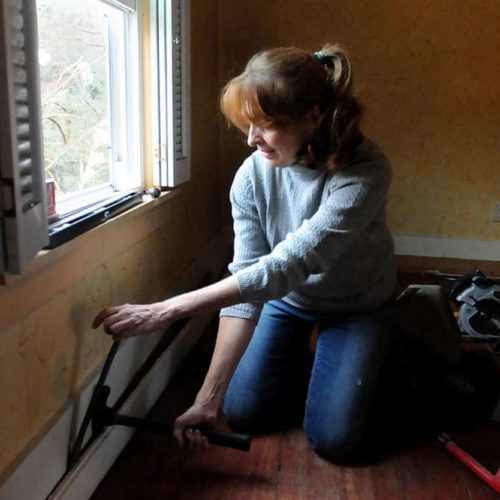Introduction

Sheila Timmons, a single mother of two from a West Virginia coal town, is fighting a legal battle against General Electric Co., one of America’s most powerful corporations.
How this happened is a story about the dream of home ownership and, Timmons claims in a lawsuit, corporate fraud.
It began one day in 1998 when she had a talk with her youngest son, Travis. He was 7 at the time.
“My baby says, ‘Mom, I want a house with a triangle roof,’” Timmons recalls. “We lived in a trailer park at the time.”
She took out a loan and paid $28,000 for a small home in Gallagher, a former coal camp where she grew up. The simple, coal company-built house — known in West Virginia’s coalfields as a “Jenny Lind” home — didn’t have much insulation. The bathroom ceiling was falling in and windows needed replacing. But it was home for Timmons and her boys and she was willing to get her hands dirty and fix up the place, doing the rehab work herself.
By 2006, she says, she decided she needed money to continue her renovations.
“I wasn’t desperate, but I was in need,” Timmons recalls.
She talked to a mortgage broker about refinancing her mortgage and pulling some cash out to make repairs and pay some debts. According to a lawsuit Timmons later filed in Kanawha County Circuit Court, she told the broker she wanted a fixed-rate loan that would roll her property insurance and taxes into her monthly payments.
She claims the broker promised her a loan with $622-a-month payment that would be fixed for two years, after which, the broker said, she could refinance and keep a fixed rate.
The appraisal was done by a West Virginia-based real-estate appraiser named Mark Greenlee. He put the value of the home at $75,000 — a figure that was double the actual market value at the time, Timmons’ lawsuit claims.
When she closed on the refinancing in November 2006, Timmons’ suit says, she didn’t receive a federally required ”settlement statement” that laid out the costs and details of her loan.
The $67,500 loan was funded by WMC Mortgage Corp., a subsidiary of General Electric since 2004.
GE shuttered WMC in 2007, but before it did, the lender booked more than $100 billion dollars in risky home loans under GE ownership. Many of them ended up going bad. One $319 million pool of mortgages funded by WMC in 2005, for example, would later show a 44 percent delinquency rate, according to a lawsuit filed against GE by federal regulators.
Timmons says she dealt with the broker and wasn’t aware that her lender was owned by the industrial giant that had made her clock radio and electric hand mixer.
About a year after Timmons signed up for her WMC loan, her suit claims, she was surprised to learn that the loan paperwork hadn’t required that money be put in escrow to cover taxes and insurance. Her loan servicer informed her that, in order to roll in the costs for insurance and taxes, her mortgage payments would have to increase to $800 a month, Timmons says.
“That was just not manageable. That was out of the question,” says Timmons, who earns about $38,000 a year working for a nonprofit agency in Charleston.
Unable to keep up with her payments, and facing the possibility of foreclosure, Timmons sought help from Mountain State Justice, a legal-aid clinic.
The suit filed by the legal clinic claims WMC engaged in a pattern of deception and predatory lending designed to land borrowers into exploitive and unfair loans. It charges that WMC “intentionally employed an appraiser to misrepresent the market value” of Timmons’ home in order to induce her into taking out the new loan.
“In West Virginia, we have so many people of modest means who own their own property,” Timmons’ lawyer, Bren Pomponio, says. In the “gold rush of the subprime explosion,” he says, many lenders used inflated appraisals to “suck them into exploitive loans” by leading them to believe their homes where worth more than they were.
A General Electric spokesman says the company denies Timmons’ allegations, but pointed to court documents for elaboration.
In court records, lawyers for WMC say Timmons received all the proper disclosures in the loan transaction. They add that any damages she may have suffered were caused by Simmons’ own actions or by others; “no part” of her alleged damages were caused by WMC, the lawyers say.
The appraiser on the deal, Mark Greenlee, pleaded guilty in September to a criminal fraud charge involving an unrelated case. Federal prosecutors said Greenlee admitted he had “prepared a false and fraudulent appraisal” in 2006 in support of a multimillion-dollar mortgage fraud scheme at a subdivision in Hurricane, W.Va.
Simmons’ own legal battle has been going on since 2008. She’d like to put it out of her mind. But she can’t.
“This has been going on for a while. It’s just a like a cloud that hangs constant,” she says. “It’s not something you can just forget.”
Read more in Inequality, Opportunity and Poverty
Inequality, Opportunity and Poverty
Why Mark Zuckerberg’s Senate hearing could mean little for Facebook’s privacy reform
Analysis: The social media company’s big lobbying and campaign investments could shield it from talk of significant regulations
Inequality, Opportunity and Poverty
The investment industry threatens state retirement plans to help workers save
States wrestle with impending retirement crisis as pensions disappear



Join the conversation
Show Comments